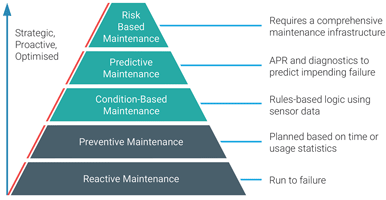

In an increasingly competitive market, organisations across multiple industries need to be able to take the bold steps necessary to optimise their maintenance strategies and operations. A rigorous, risk-based maintenance solution that can evaluate how cost, risk and performance should be balanced over time to deliver sustainable outcomes isn’t a choice anymore, but a necessity.
Implementing Asset Performance Management (APM) 4.0 enables the transition to full risk-based maintenance for improved asset performance, increased asset reliability, reduced risk, and ultimately, maximum return on asset investments.
Innovative companies are reaping the benefits of implementing proactive maintenance strategies today. When a major dairy company implemented risk-based maintenance, the result was 30% spare parts cost reduction and a 3% increase in productivity in the first year. The investment paid for itself sevenfold on a yearly basis, and the APM implementation also initiated a systemic cultural shift as the existence of extensive data libraries enabled a company-wide culture of risk awareness, asset responsibility, and problem ownership.
The maintenance maturity pyramid and APM 4.0
When discussing APM 4.0, it is important first to consider the five levels of maintenance, the value of each approach and where they fit into a comprehensive maintenance strategy. The maintenance maturity pyramid helps to represent the journey towards more proactive and optimised maintenance execution, all of which should be embedded in a solid asset management system based on ISO 55000. Enterprise-wide data management, risk management and mitigation form the foundation for a comprehensive APM
strategy.

At the bottom of the maintenance maturity pyramid is the most basic approach, reactive maintenance. Reactive maintenance involves letting an asset run until it fails, then repairing or replacing it. This is suitable for non-critical assets that have little to no immediate impact on safety or plant availability and have minimal repair or replacement costs. However, the drawbacks of reactive maintenance are clear, as it is completely unsuitable for high-cost or mission-critical assets.
The next level of maintenance maturity is preventive maintenance, which is regularly scheduled maintenance implemented in hopes that an asset will not reach the point of failure. The preventative maintenance strategy prescribes maintenance work to be conducted on a fixed time schedule or based on operational statistics and manufacturer/industry best practice recommendations. However, if preventive maintenance is not optimally implemented, it can either be applied too frequently, leading to large maintenance costs, or infrequently, causing potential issues. Preventive maintenance can be managed in the Enterprise Asset Management (EAM) or Computerised Maintenance Management System (CMMS).
Some equipment failure patterns are not related to ageing or usage and appear to happen randomly, hence condition-based maintenance (CBM) is sometimes recommended. CBM focuses on the physical condition of equipment and how it is operating and is ideal when measurable parameters are good indicators of impending problems. The condition is typically defined using rule-based logic, where the rule does not change depending on loading, ambient or operational conditions. If the condition is met, work orders can be automatically generated to help mitigate risk and proactively resolve potential problems.
For more complex and critical assets, a predictive strategy is appropriate. Using predictive maintenance (PdM), organisations can move from asking “Why did that happen?” to “What will happen?” Predictive maintenance solutions learn an asset’s unique operating profile during all loading, ambient and operational process conditions. Existing sensor data is compared to real-time operating data using advanced analytical modelling techniques to determine and alert upon subtle deviations from expected behaviour. Once an issue is identified, root cause analysis and fault diagnostics help the user to determine the significance of the problem and the resulting course of action. These early warning notifications enable users to address issues before they become problems that significantly impact operations.
At the very top of the maintenance maturity pyramid, the implementation of risk-based maintenance involves a comprehensive maintenance strategy that leverages existing data, advanced analytics and simulations and forecasts to understand the true issues driving asset performance and reliability. By implementing risk-based maintenance, organisations can move beyond preventing failure, and towards optimising future performance – from “What will happen?” to “What should we do?” This moves the asset from a cost centre to a major driver of profitability for the business.
Risk-based maintenance
Implementing risk-based maintenance delivers numerous benefits for organisations. First, getting the most out of your existing production assets is a key success factor in achieving business objectives. Risk-based solutions allow companies to prioritise asset management by focusing on the assets that need attention. Advanced asset criticality analysis ensures the most important assets receive priority and more rigorous analysis for optimal maintenance. When asset failures occur, root cause analysis enables users to diagnose the cause and act to eliminate reoccurring incidents. Inventory management quantifies the effect of spare parts to optimise asset management levels.
The second key benefit of risk-based maintenance is strategic. By practicing a future-focused, risk-based asset management strategy, users can perform detailed analysis and simulations to visualise the effects of deploying different asset management strategies, and ultimately, achieve short-term efficiencies and long-term sustainability. In-depth risk analysis provides detailed insight into the real factors driving asset reliability and performance, facilitating long-term planning. Extensive simulation capabilities allow users to see the impact of differing asset management approaches, enabling an aligned strategic approach to operations and asset management.
How we allocate resources efficiently and fairly between competing short and long-term (commercial, social, environmental) interests is one of the largest pain points of asset-intensive industries. Therefore, it is important to consider the role and impact of accurate financial forecasts, as unexpected shifts in capex and opex budgets can derail even the most well-laid asset management plans. Advanced risk-based maintenance tools allow users from different business units to design, simulate, measure and optimise capex and opex assessment plans, ensuring that asset management plans accurately reflect the likely financial future. Risk-based maintenance technologies can provide quick time to value – a solution with an extensive library of readily available reliability data can speed up deployment time by up to 90%.
Providing closed-loop optimisation
A comprehensive APM solution enables an APM 4.0 approach by ensuring that maintenance strategies are deployed in the most efficient and effective manner possible. APM solutions manage the collection of data from any number of sources, incorporate advanced analytics technology that combine rules-based logic and machine learning, and can trigger actions in the work order system to manage asset lifecycle and maintenance processes. These solutions help maintenance teams, systems engineers, controllers and many others take advantage of the massive amounts of data available today and use it to answer questions and make real-time decisions to maximise asset reliability and performance.
Using APM, engineers can identify and predict asset failures early, so personnel can spend less time sifting through raw data and more time resolving issues. Integration with advanced workflows facilitates the continuous improvement process, constantly driving improved operational excellence.
An open-ended and hardware-agnostic solution enables easy integration with existing systems.
On the front end of an APM implementation, conducting an APM assessment can be an invaluable tool in getting started. A good APM assessment will evaluate all facets of a company’s asset management strategy, including the business context, to determine potential areas of improvement. Experienced consultants will distil these findings into a thorough action plan, providing an ideal guide for companies looking to take the first step.
Conclusion
Asset intensive industries are under continuous pressure to improve the operations of their assets while maintaining regulatory compliance. Leveraging new technologies such as cloud, big data management, machine learning and analytics can drastically improve the enterprise’s ability to plan, forecast and optimise maintenance strategies to improve asset performance management.

© Technews Publishing (Pty) Ltd | All Rights Reserved